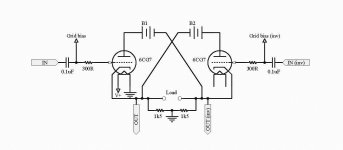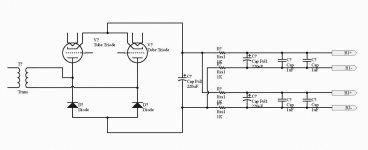I'm about half way thorugh implementing a soft start for my tube-dac.
It's a timer circuit that shorts the outputs to ground...
I'm always looking for better/smarter solutions.
Recently I came across some reference to tube rectifiers being used and functioning like a soft start device?
I'm a tube n0ob so this was all news to me.
How would you solve the soft start issue?
I'm trying to prevent spikes at the output when switching on the tube buffer.
It's a timer circuit that shorts the outputs to ground...
I'm always looking for better/smarter solutions.
Recently I came across some reference to tube rectifiers being used and functioning like a soft start device?
I'm a tube n0ob so this was all news to me.
How would you solve the soft start issue?
I'm trying to prevent spikes at the output when switching on the tube buffer.
The nature of the tube rectifier is that it won't start rectifying until it is in itself warm, so your HT won't come up until the tube is warm, and it comes up gradually. My tube DAC has a foul SRPP stage which I keep meaning to ditch, but I get no pops when switching on. It uses an EZ80 rectifier.
Using tube rectification sounds like a neat idea. Avoid extra complexity, just add a rectifying tube?
Now, if only I knew how?
Oh, I almost forgot... The PSU's are floating.
What heater voltage do you have?
Out of the LM317 datasheet with a twist. By putting an HV PNP transistor across the adjust resistor, and using an RC to slowly turn off the transistor you can use a "Slow MAIDA" regulator -- this one takes about 30 seconds to reach full potential -- about the time for filaments to hot up:
SY will probably tell me it's a profoundly bad idea...
An externally hosted image should be here but it was not working when we last tested it.
SY will probably tell me it's a profoundly bad idea...
I'm about half way thorugh implementing a soft start for my tube-dac.
It's a timer circuit that shorts the outputs to ground...
I'm always looking for better/smarter solutions.
Recently I came across some reference to tube rectifiers being used and functioning like a soft start device?
I'm a tube n0ob so this was all news to me.
How would you solve the soft start issue?
I'm trying to prevent spikes at the output when switching on the tube buffer.
Just for interest,
I think the soft start covers three issues:
1. As stated slow turn on of B+
2. Soft start of heater inrush current.
3. Output mute until stabilization of all power.
Regards
M. Gregg
Just for interest,
I think the soft start covers three issues:
1. As stated slow turn on of B+
2. Soft start of heater inrush current.
3. Output mute until stabilization of all power.
4. Limit inrush current through charging filter capacitors.
For #1 big time constant of RC and a source follower is a good cheap solution. For #2 and #4 wirewound resistor in series with primary of power transformer, shunted by contacts of relay powered from filament voltage rectifier, is a good cheap solution.
#3 is a different story, I would use there FET switches shunted by relay contacts.
I'm about half way thorugh implementing a soft start for my tube-dac.
It's a timer circuit that shorts the outputs to ground...
I'm trying to prevent spikes at the output when switching on the tube buffer.
That's not a soft-start circuit. That's a mute circuit.
A soft-start circuit or in-rush limiting circuit limits the surge in current that runs through the mains transformer at turn-on. A tube rectifier with a slow warm-up characteristic may be helpful here.
However, a in-rush limiter will not do much to limit turn-on thumps (fluctuations in the amp output voltage) at turn-on. A mute circuit like the one you describe will be helpful here. There are many ways to do this, but a simple timer circuit that turns on the amp output after, say, 30 seconds is probably the simplest.
~Tom
Yeah, I guess you're right.
I was thinking there are two ways. (mainly)
Either apply a mute at the output. (Short output to ground with a relay)
Or use tubes for rectifying, the audio should come on gradually? Will there still be a risk for thumps? Using tube rectification looks like the easiest path?
Smallest amount of extra circuitry...
I was thinking there are two ways. (mainly)
Either apply a mute at the output. (Short output to ground with a relay)
Or use tubes for rectifying, the audio should come on gradually? Will there still be a risk for thumps? Using tube rectification looks like the easiest path?
Smallest amount of extra circuitry...
That's not a soft-start circuit. That's a mute circuit.
A soft-start circuit or in-rush limiting circuit limits the surge in current that runs through the mains transformer at turn-on. A tube rectifier with a slow warm-up characteristic may be helpful here.
However, a in-rush limiter will not do much to limit turn-on thumps (fluctuations in the amp output voltage) at turn-on. A mute circuit like the one you describe will be helpful here. There are many ways to do this, but a simple timer circuit that turns on the amp output after, say, 30 seconds is probably the simplest.
~Tom
How would you solve the soft start issue?
I'm trying to prevent spikes at the output when switching on the tube buffer.
The heaters take some time to warm up, up to 20 seconds, that will give you a soft start. You won't get any spikes. I can't see any need for any additional circuits.
In that case, it seems like a no-brainer. If I go with tube rectification my problems are solved?
This however brings us to the practical matters.
The power supplies are floating with both positive and negative attaching to the circuit.
(Circlotron...)
How do I hook it up?
What tubes should I use and what values are ok on the other components?
At the moment I'm using a 220uF cap as the first cap then a symmetrical RC filter with another 220uF cap. (series R both on the negative and positive side.)
This however brings us to the practical matters.
The power supplies are floating with both positive and negative attaching to the circuit.
(Circlotron...)
How do I hook it up?
What tubes should I use and what values are ok on the other components?
At the moment I'm using a 220uF cap as the first cap then a symmetrical RC filter with another 220uF cap. (series R both on the negative and positive side.)
I figured I could throw in a schematic overview of the actual buffer circuit.
In = Signal in from the dac. (One regular and one inverted.)
Output = I tap the output for a servo circuit
B1 & B2 are the actual power supplies.
Bias is simply where I hook up the bias supplies.
In = Signal in from the dac. (One regular and one inverted.)
Output = I tap the output for a servo circuit
B1 & B2 are the actual power supplies.
Bias is simply where I hook up the bias supplies.
Attachments
I'll trust you if you say it's a good match but I don't speak russian and since this is my first try at tube rectification it's kind of difficult just winging it?
I'm aiming for 150VDC and the transformer is 150VAC.
Do I just replace two SS diods in a bridge (creating a hybrid bridge)? How many volts will drop over the tubes?
I'm aiming for 150VDC and the transformer is 150VAC.
Do I just replace two SS diods in a bridge (creating a hybrid bridge)? How many volts will drop over the tubes?
Last edited:
I would add this damper diode in series with a filter choke, between filter capacitors. In such case you are not limited in capacitance domain by peak tube current.
I don't know exactly how much damper diode drops, I did not try it for myself, but I know it will work.
However, using softer start of B+ you can minimize turn-on thump, but what about turn-off one?
I don't know exactly how much damper diode drops, I did not try it for myself, but I know it will work.
However, using softer start of B+ you can minimize turn-on thump, but what about turn-off one?
Or use tubes for rectifying, the audio should come on gradually? Will there still be a risk for thumps?
Depends on the design of the amp. I have built amps both with silicon rectification and tube rectification. Some of them have thumped others have not. In one case, I changed from a tube rectifier to a silicon rectifier and the thump didn't seem to change. I think it depends on how fast bypass and coupling caps charge up and bias currents stabilize.
If you don't want a thump, mute the output. If you can accept minimum thump, you can either rely on the slow warm-up of the heaters in your signal tubes (in which case you use whatever rectifier you want) or try the slow rise in output voltage that a vacuum tube rectifier offers.
~Tom
- Status
- This old topic is closed. If you want to reopen this topic, contact a moderator using the "Report Post" button.
- Home
- Amplifiers
- Tubes / Valves
- Soft start for a preamp?

